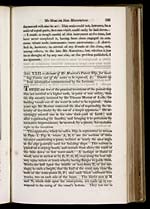James Watt (1736-1819)
Account of micrometers for measuring distances
Mr Watt on New Micrometers.
125
the second will also be so. Thìs scale could not, however, be a
scale of equal parts, but one which could easily be laid down.
I made a rough model of this instrument at the time, but
have never completed it, having been since engaged in con-
cerns where such instruments were unnecessary. I descri-
bed it, however, to several of my friends at the time, and,
among others, to the late Mr Ramsden; but whether it has
been thought of by any one else, or the problem published, I
am ignorant.
________________________________________________
ART. XXII.—Account of Mr MORTON’s Patent Slip, for haul-
ing Vessels out of the water to be repaired, &c. Drawn up
from information communicated by the Inventor.
THERE are few of the practical inventions of the present day
that are entitled to a higher rank, in point of real utility, than
the slip recently invented by Mr Thomas Morton of Leith, for
hauling vessels out of the water in order to be repaired. Some
years ago Mr Morton conceived the idea of superseding the ne-
cessity of dry-docks by the use of a simple apparatus. He ac-
cordingly erected one in his own dock-yard at Leith; and
after experiencing its benefits, and bringing it to perfection by
successive improvements, he secured, by a patent, his exclusive
right to the invention.
This apparatus, which he calls a Slip, is represented in section
in Plate I. Fig. 6. where A, B, C are the sections of three
railways constituting a plane, inclined at nearly the same angle
as the slips generally used for building ships. This railway is
placed on a sloping beach, and extends from above the reach of
the tide down to low water-mark. A carriage or frame of
wood, seen in section at D, E, F, G, H, runs along the iron rail-
way upon rollers or truck-wheels, having flanges to guide them.
Blocks are laid upon the middle or keel-beam E, of the car-
riage, to such a height, that the keel of the vessel may clear the
ends of the cross-pieces D, F; and each block embraces four
trucks, two on each side of the beam. The blocks seen at M
and N, which slide upon the cross-pieces, are made up to cor-
respond to the rising of the vessel’s bottom. They run out to


